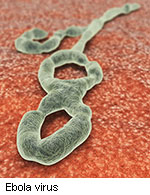Researchers suggest close contact with droplets could create exposure
FRIDAY, Feb. 20, 2015 (HealthDay News) — Based on prior evidence, health workers dealing with Ebola primarily have worried about disease transmission from a patient’s blood, vomit, and feces, all of which contain high levels of virus as symptoms progress, but health care workers also might need to worry about a patient’s cough, authors speculate online Feb. 19 in mBio.
According to the study authors, the saliva of an Ebola patient does contain traces of the virus. Also, the amount of virus in bodily fluids such as blood, saliva, vomit, and diarrhea increases as they grow more ill, noted the report from the University of Minnesota Center for Infectious Disease Research and Policy. Ebola attacks nearly all the body’s organs, including the lungs. So, if a caregiver breathes in droplets coughed by an Ebola patient, “it is possible that primary pulmonary infections could occur,” the Minnesota team writes.
The report authors cite a well-known animal study in which two monkeys caged in the same room as three monkeys with Ebola became ill with the virus themselves, even though there was no physical contact. Droplet transmission might explain the spread, the researchers noted. Monkeys tend to spit at each other and throw feces, and this activity could have created Ebola-laden aerosol droplets that infected the healthy monkeys via their respiratory tracts or their mucous membranes.
“The West Africa Ebola epidemic surprised even the most astute infectious disease experts in the global public health community,” the authors conclude. “We should not assume that Ebola viruses are not capable of surprising us again at some point in the future.” Still, they stress that airborne transmission of Ebola — similar to that which occurs with the flu or measles — remains unlikely in the future, given that it would require the virus to undergo a substantial mutation.
Copyright © 2015 HealthDay. All rights reserved.








